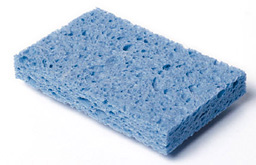H1N1 Flu: Where Germs Are Hiding

With news reports about the H1N1 flu all over the place, you may not think about the old “stomach flu” right now. Did you know that there really is no such thing as the stomach flu? If you have diarrhea or vomiting, it is usually not from influenza virus, but rather from another bug that got you. Often these bugs get us from not properly handling our food or from unsanitary conditions in our kitchens. Don’t go blaming the restaurant so quickly because studies show our homes are a breeding ground for bacteria that make us sick, too!
Top places germs reside
- The kitchen sponge and/or dishcloth is the number one place for nasty bugs to hang out. Replace your sponge every few weeks, or put it through the dishwasher so the heat can kill off some of the bacteria.
- The bottom of the sink is also very high in bacterial count. Just think about the conditions that germs love: Warm, moist environments. Your sink, sponges, and dishtowels are often wet and bacteria love it!
- Keyboards, computer mouse, remote controls, doorknobs, etc. I am guilty of this too: You are working on your computer and then you reach for a snack. There is a ton of bacteria on surfaces all over your office and home. Wash your hands every time you go to eat something. The toilet actually has less bacteria than many commonly touched surfaces around your office and home.
Tips to prevent getting sick
- WASH HANDS. I can’t emphasize this enough. Wash your hands before you go to prepare food or eat food. Wash your hands after you go to the bathroom. A good rule of thumb is to wash for at least 20 seconds using hot water and lots of soap. Use a hand sanitizer if you cannot always wash in a sink.
- Wash all surfaces food will touch before and after you prepare food. Wipe the counter clean before you get the food out, and wash it off after as well.
- Wash all produce well. Even if you don’t eat the outside of it (think watermelon, cantaloupe, oranges, etc) you still want to wash it. Once you cut into it or peel it, the outside is getting on the inside with the trail of the knife or your hands.
- Always cook meats to an internal temperature of 165 degrees. Use a food thermometer to be sure.
- Do not keep perishable food out for more than 2 hours at room temperature. Get all food back into the fridge in 2 hours or less to minimize bacteria multiplying.
- Keep your fridge at 40 degrees or less.
Check out this research from the USDA:
Best Ways To Clean Your Kitchen Sponge
Your microwave or dishwasher can make sponges safer to reuse in today’s kitchens.
Heating your used kitchen sponges in your microwave for one minute, or washing them in your dishwasher and leaving them there through a drying cycle, are the most effective household ways to inactivate harmful bacteria, yeasts and molds.
ARS food safety experts who specialize in research on foodborne pathogens, like E. coli O157:H7, looked at several simple, convenient and often-recommended ways of cleaning reusable kitchen sponges. Techniques included soaking sponges for three minutes in a 10-percent chlorine bleach solution, soaking in lemon juice or sterile water for one minute, heating in a microwave at full power for one minute, or washing in a dishwasher—including through a drying cycle.
At the outset of the experiment, they soaked all the sponges for 48 hours at room temperature in a slurry of ground beef and laboratory compounds which allow bacteria, yeasts and molds naturally present in the beef to grow on the sponges.
Microwaving and dishwashing each killed nearly 100 percent of the bacteria, with dishwashing being only slightly (0.0001 percent) less effective.
And, microwaving and dishwashing each killed nearly all yeasts and molds; less than 1 percent (only 0.00001 percent) survived.
This post, H1N1 Flu: Where Germs Are Hiding, was originally published on Healthine.com by Brian Westphal.











